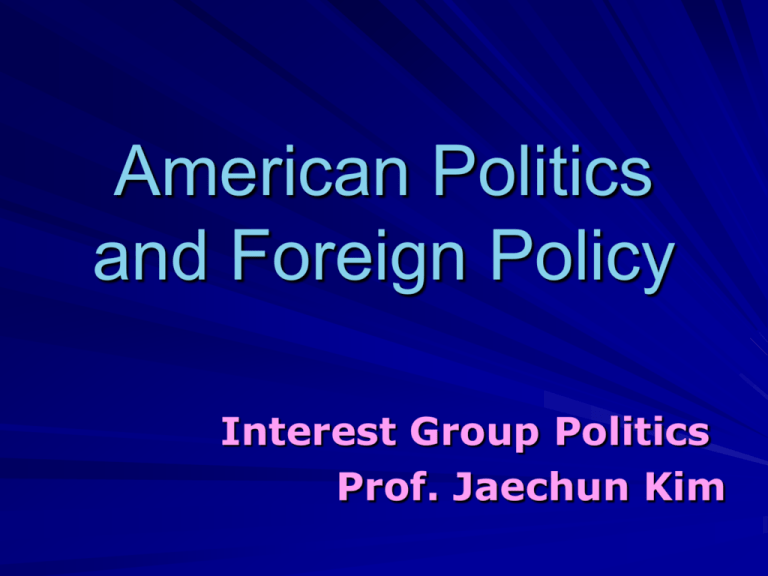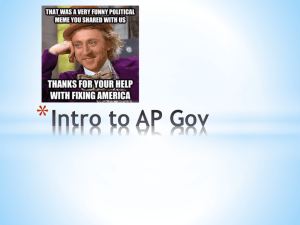Politics by Interest Groups
advertisement

American Politics and Foreign Policy Interest Group Politics Prof. Jaechun Kim Politics by Interest Groups Activities of Interest Groups and Passage of Aviation Security Bill (2001. 11) November 2001, GWB signed into law an aviation security bill… Before the bill was passed, security check at airports had been the responsibility of the airlines and local airport authorities… Usually they contract out the job to the private companies… The job required little experiences and education… little background checks for airport security personnel… The demand for improved security after 911 – The Senate favored making airport security a federal responsibility… and making all screeners federal employees. But Airline Security Association (ASA) launched a major lobbying effort to keep private corporations in business… The initial proposal for the bill Screeners should have been US citizens for at least five years Screeners, being federal employees, should be prohibited from striking… But most of the screeners had been the US citizens for less than a year… Groups that represent immigrants and the Hispanic Americans lobbied against the proposal… Also unions lobbied against the proposal… The End Result A compromise!!! Aviation security became a federal responsibility, and all passenger and baggage screeners should become federal employees within a year… (got rid of 5 year citizenship requirement…!) After two years of this system, an airport could go back to private contractors, but only under federal supervision… American public wanted security, but still interested parties continued to lobby and jockey over this important legislation… ! Interest group politics is still intact even in times of security crisis! American Politics is Politics by Interest Groups?: (Prevalence of Interest Group Politics in the US) Alexis de Tocqueville, Democracy in America (1834) – “in no country of the world has the principle of association been more successfully used or applied to a greater multitude of objectives than in America.” Toqueville was amazed at the degree to which Americans formed groups to solve civic problems… to advance their political and economic interests… James Madison – “Liberty is to faction what air is to fire” (Federalist No. 10) ..Warned that faction can be dangerous, but inevitable… This is not just OK, but desirable… why? James Madison - The multitude of interests would work to discourage the formation of an oppressive larger minority or majority interest… so interest groups politics is not that bad after all… actually, good for preventing tyranny of majority… !! Today there are more than a hundred thousand associations in the United States. More than two-thirds of all Americans belong to at least one group or association. The majority of these groups are interests groups… Why So Many and So Powerful in the US? Constitutional guarantee - Not only are all people guaranteed the right “peaceably to assemble,” but they are also guaranteed the right “to petition the Government for a redress of grievances.” (First Amendment to the U.S. Constitution) but this right is guaranteed elsewhere!! Peculiarity of the American System of Governance Decentralized authority for decision-making…!! For instance, the federal system of government provides thousands of “pressure points” for interest group activity. Americans can form groups in their neighborhoods or cities and lobby the city council and their state government… Municipal, state, national level… Also separation of power helps proliferation of interest group politics - groups can influence government policy through the Congress or through one of the executive agencies or cabinet departments. If this fails, you can file suit in state or federal courts… Openness of the American political system as a major factor in the power of groups in American politics! Some say that, since parties are not that strong in the American politics, interest groups fill in the void that parties have left…(American parties are basically “catch-all party,” and party leadership and structure is decentralized and party discipline is weak). Why Do (Americans) Join Interest Groups? Solidary Incentives – companionship, a sense of belonging, and the pleasure of associating… Material Incentives e.g., AARP (the American Association of Retired Persons) – one of the most powerful and largest interest groups; provides discounts, insurance plans, and organized travel opportunities for its members. The material incentives far outweigh the membership costs ($12.50). Purposive Incentives People join the group and then feel that they are doing something about a cause that is important to them. e.g., groups focusing on the abortion or gun control… Types of Interest Groups in the US Economic Interest Groups (as opposed public interest groups) More interest groups are formed to represent economic interests than any other type of interests. Business Interest Groups • Thousands of business groups and trade associations work to influence government policies that affect their respective sectors. e.g., • The U.S. Chamber of Commerce - more than 200,000 member companies; “umbrella group” that represent business interests in general…; can bring constituent influence on virtually every member of Congress • The National Association of Manufacturers - a staff of more than sixty people in Washington, D.C.; manufacturing concerns… • The American Pet Products Manufacturers Association – manufacturers of pet food and pet toys… ; represent interests of pet products manufacturers… Agricultural Interest Groups e.g., • The American Farm Bureau Federation, established in 1919, has over 4.9 million members. • The National Farmers' Union (NFU) – more liberal In May 2002 President George W. Bush signed the Farm Security and Rural Investment Act, which authorized the largest agricultural subsidy act in US history. Labor Interest Groups • e.g., AFL-CIO Interest groups representing the labor movement date back to at least 1886 when the American Federation of Labor (AFL) was formed. In 1955, the AFL joined forces with the Congress of Industrial Organizations (CIO). Today, the combined AFL-CIO is a large union with a membership exceeding 13 million. Public Employee Interest Groups • The degree of unionization in the private sector has declined since 1965, but this has been partially offset by growth in the unionization of public employees. They have become quite militant and are often involved in illegal strikes. • e.g., The National Education Association (NEA) - a nationwide organization of about 2.5 million administrators, teachers, and others connected with education. Environmental Groups (part of public interest groups) The groups range from the National Wildlife Federation, with a membership of more than 4.5 million and an emphasis on education, to the fairly elite Environmental Defense Fund, with a membership of 300,000 and a focus on influencing federal policy. Public-Interest Groups (as opposed to economic interest groups) e.g., Nader Organization – The best-known and perhaps the most effective public-interest groups are those organized under the leadership of consumer activist Ralph Nader. Ralph Nader - Unsafe at Any Speed (1965); In 2000, 2004, Nader ran for president on the ticket of the Green Party… ; champion of consumer interests..; sixty public interest groups under his belt… Tea Party Movements – http://teapartypatriots.ning.com/ Other Interest Groups A number of interest groups focus on just one issue. The abortion debate has created various groups opposed to abortion (such as the Right to Life organization) and groups in favor of abortion (such as the National Abortion Rights Action League). NRA… etc. Foreign Governments Washington, D.C., is also the center for lobbying by foreign governments as well as private foreign interests; largest American trading partners have lobbyists in DC… Often times they hire former high rank government officials… What makes interest group powerful? Size and Resources No legislator can deny the power of an interest group that includes thousands of his or her own constituents among its members…. AFL-CIO – 13 million AARP – 35 million; represent 20 percent of the population… These groups have money!! They can hire powerful lobbyists … sponsor TV ads… etc. Lobbying Techniques - Most lobbyists today are professionals. Firms employ hundreds of former members of Congress and former government officials, including former presidential candidates such as Bob Dole and Walter Mondale. – Revolving door syndrome : leaving public officers reappearing immediately as lobbyists – causing ethics problem… The Ratings Game - Many interest groups attempt to influence the overall behavior of legislators through their rating systems. Congressman is given a score based on the percentage of times he/she voted in favor of the group’s positions… “Dirty Dozen” by the environmental group… Interest Groups and Campaign Financing PAC(Political Action Committee) – direct contribution; Congress people get more than 1/3 of their funding from PACs… Indirect contribution by “Soft Money”; no longer a force??? … no it returned! Issue Advocacy Advertising – advertise their positions on issues they advocate during the election periods…; not allowed to tell “vote for” or “vote against”… but…still exerts huge influence during election time… Who Governs in the US? Elite theory of governance Elite theory of governance - a perspective holding that society is ruled by a small number of people who exercise power • C.W. Mill, Power Elite (1956) – A small, cohesive elite class that makes almost all the important decisions regarding the nation... Groups have upper-class bias (business or professional interests groups are most powerful); leaders of groups are “elite within an elite” If interests groups are led by elites, upper-class people, what we see is a conflict among elites… Unlike the intention of founding fathers, multitude of groups does not diffuse power… rather groups politics tend to concentrate power… K Street Project… an effort by the Republican Party (GOP) to pressure Washington lobbying firms to hire Republicans in top positions, and to reward loyal GOP lobbyists with access to influential officials, Ignorant mass public; smart elites – elitist policy produces better outcomes (normatively)… Critiques – it’s “democracy for the few!” Democracy for Groups Pluralist theory of governance – A theory that views politics as a conflict among interest groups. Political decision-making is characterized by bargaining and compromise among a variety of groups. • Robert Dahl, Who Governs? (1963) – Study of New Haven city politics; it’s the groups that make crucial decisions… Politics is the struggle among groups to gain benefits for their members. Given the structures of the American political system, group conflicts tend to be settled by compromise and accommodation so that each interest is satisfied to some extent.!!! (Multiple pressure points – no single interests can dominate…People have multiple membership to different interest groups!) Cf. The danger of hyperpluralism, meaning that groups and their needs control the government and decision making rather than the government's acting for the good of the nation. Which view do you think is more convincing? Do interest groups help make government responsive in the US? What about in your own country? – Indeed they do seem to help make government responsive … The task of government is too huge and diverse to expect that citizens’ concerns will be properly addressed by elected officials… Interest groups can communicate these issues to the elected officials… But the problem is that interest groups do not represent all interests… equally… Business interests dominate in the US – Concern of Obama..?! Interest groups put more pressure on the elected officials than voters… Interest groups provide resources… Politicians pursue agendas set by business interests.. Captives of business interests.. Special interests… What about average people??







